Viewing: Blog Posts Tagged with: George Ancona, Most Recent at Top [Help]
Results 1 - 6 of 6
Blog: La Bloga (Login to Add to MyJacketFlap)
JacketFlap tags: review, George Ancona, Ariadna Sánchez, Don Ricardo, Ejutla de Crespo, El Piñatero/The Piñata Maker, Tío Rico, Add a tag
Blog: Picture Books & Pirouettes (Login to Add to MyJacketFlap)
JacketFlap tags: Capoeira, George Ancona, Share a Story, Shape a Future, Multicultural, Add a tag
Also on day 2, the Share a Story-Shape a Future hosts posted the following prompt to encourage other bloggers to share their favorite books about other cultures: "An acquaintance wants a book about a culture unlike his/her own.... You've got 100 words to pitch your favorite book. Pitch us!"
Well, I have quite a large pile of dance books on the floor in my bedroom, all waiting for the lucky day when they are chosen as the highlight of my next blog post. And wouldn't you know? One of them was about dance from another culture! So here goes my pitch...
Capoeira, which has been described as a way of life in Brazil, is now popular in many parts of the world. But what is it? A game? A dance? A martial art? Believe it or not, it's all three! Award-winning photographer and author George Ancona brings this fascinating activity and its African and Portuguese origins to life in the picture book Capoeira, published in 2007 by multicultural publisher Lee and Low Books. You will be amazed by the cunning technique and playful spirit of the many young capoeiristas who are featured in this book!
- Drumbeat in Our Feet (A
2 Comments on Share a Story: The Culture of Reading, last added: 3/14/2012Display Comments Add a Comment
Blog: The Children's Book Review (Login to Add to MyJacketFlap)
JacketFlap tags: Sports, Picture Books, Jane Yolen, Books for Girls, George Ancona, Ages Nine to Twelve: Books for Third Through Sixth Grade, Book Lists: Specialty Picks, Christine Davenier, Ages Four to Eight: Books for Pre-School Through Second Grade, Ann-Marie Williams, Heidi E.Y. Stemple, Helene Kerillis, Jeff Kulak, Lucie Albon, race Maccarone, Add a tag
By Nicki Richesin, The Children’s Book Review
Published: November 3, 2011
It’s such a pleasure to introduce children to new subjects, such as dance, through literature. Watching them discover a new love for learning about a topic they’ve yet to explore is pure joy. These books will open a ballroom door to the world of dance in its wide variety of forms, from the gypsies who migrated from India to Spain to the prima ballerina who dedicates her life to her craft.
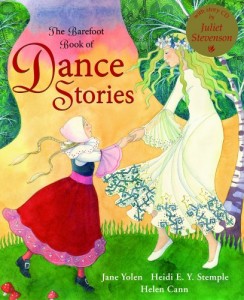 The Barefoot Book of Dance Stories
The Barefoot Book of Dance Stories
By Jane Yolen and Heidi E.Y. Stemple
The Barefoot Book of Dance Stories by Jane Yolen and Heidi E.Y. Stemple is an eclectic collection including dance tales from Germany (The Twelve Dancing Princesses) Japan (Robe of Feathers) West Indies (Making the Stone Smoke) Spain (The Shepherd’s Flute) Czech Republic (Dancing with the Birch Fairy) Egypt (When The Goddess Danced) Scotland (Tam O’Shanter) and Mali (The Little Bird Who Went Dancing). Helen Cann’s paintings move and sinuate across the pages with brilliantly colorful strokes. Best of all, this book includes a CD with lively background music and grand dame of stage and screen Juliet Stevenson narrating the stories with her warm and gentle voice. (Ages 8 and up)
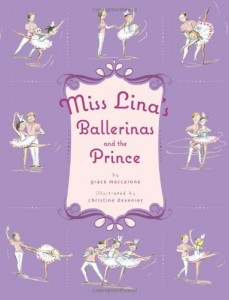 Miss Lina’s Ballerinas and the Prince
Miss Lina’s Ballerinas and the Prince
By Grace Maccarone; illustrated by Christine Davenier
Miss Lina’s Ballerinas and the Prince is an amusing tale of a classroom of little ballerinas who must welcome a new student, a boy. Quelle horreur! Grace Maccarone’s book is somewhat reminiscent of the Madeline and the Bad Hat (although this boy is not nearly as horrid as Pepito) with its rhyming lilt and even Christine Davenier’s illustrations remind me a bit of the little girls in Paris visiting the zoo with dear Miss Clavel. No need to fear, the prince doesn’t upstage the girls and all’s well that ends well for the little ballerinas of Messina. (Ages 3-6)
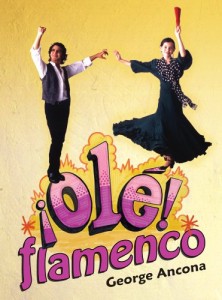 Ole! Flamenco
Ole! Flamenco
By George Ancona
Add a CommentBlog: The Children's Book Review (Login to Add to MyJacketFlap)
JacketFlap tags: Latino, Peter Sis, David Diaz, Margarita Engle, Carmen Tafolla, Pura Belpré Award, Pam Munoz Ryan, George Ancona, Award Winners: Books with honors, Cultural Wisdom: Books that teach, Eric Velasquez, Amy Novesky, Amy Cordova, Duncan Tonatiuh, Enrique Flores-Galbis, Add a tag
By Bianca Schulze, The Children’s Book Review
Published: January 10, 2011
As announced by the American Library Association (ALA) …
Pura Belpré (Author) Award
Honoring a Latino writer whose children’s books best portray, affirm and celebrate the Latino cultural experience:
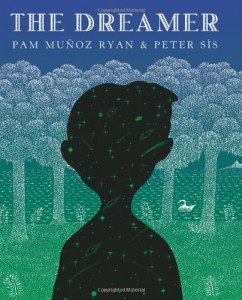
“The Dreamer,” written by Pam Muñoz Ryan, is the 2011 Belpré Author Award winner. The book is illustrated by Peter Sís and published by Scholastic Press, an imprint of Scholastic Inc.
Three BelpréAuthor Honor Books were named:
“¡Olé! Flamenco,” written and illustrated by George Ancona and published by Lee & Low Books Inc.; “The Firefly Letters: A Suffragette’s Journey to Cuba,” written by Margarita Engle and published by Henry Holt and Company, LLC; and “90 Miles to Havana,” written by Enrique Flores-Galbis and published by Roaring Brook Press, a division of Holtzbrinck Publishing.
Pura Belpré (Illustrator) Award
Honoring a Latino illustrator whose children’s books best portray, affirm and celebrate the Latino cultural experience:
“Grandma’s Gift,” illustrated and written by Eric Velasquez, is the 2011 Belpré Illustrator Award winner. The book is published by Walker Publishing Company, Inc., a division of Bloomsbury Publishing, Inc.
Three Belpré Illustrator Honor Books for illustration were selected:
“Fiesta Babies,” illustrated by Amy Córdova, written by Carmen Tafolla and published by Tricycle Press, an imprint of the Crown Publishing Group, a division of Random House, Inc.; “Me, Frida,” illustrated by David Diaz, written by Amy Novesky and published by Abrams Books for Young Readers, an imprint of ABRAMS; “Dear Primo: A Letter to My Cousin,” illustrated and written by Duncan Tonatiuh and published by Abrams Books for Young Readers, an imprint of ABRAMS.
Add a Comment
Blog: PaperTigers (Login to Add to MyJacketFlap)
JacketFlap tags: A Pause for Breath, Join Hands!, Robyn Sarah, Poetry Friday, Picture Books, Pat Mora, Poetry Books, pantoum, George Ancona, Teaching Books, Add a tag
 As a poet, I’m always interested in new poetic forms. Join Hands! by Pat Mora (with photographs by George Ancona, Charlesbridge, 2008) introduced me to the pantoum. The pantoum is a poetic form derived from Malaysia. It is composed of quatrains where the second and fourth lines are repeated as the first and third lines of the following quatrain. In Join Hands!, Mora uses the form (with slight alterations in her repeating lines) to create a poem about celebrating life through dancing, singing, masquerading and parading. The book takes you through the lines, one line per page, with accompanying photograph per line. A few Spanish words like ‘amigos’ and ‘canciones’ are used. (Mora is known for her bilingual Spanish/English books.) The explanation of the form comes at the end of the book. I wish it had come at the beginning, however! Reading the text linearly while viewing the picture made it seem a bit confusing. However, I did enjoy the lively photographs by George Ancona, accompanying each line. They feature children dancing and strutting and holding hands.
As a poet, I’m always interested in new poetic forms. Join Hands! by Pat Mora (with photographs by George Ancona, Charlesbridge, 2008) introduced me to the pantoum. The pantoum is a poetic form derived from Malaysia. It is composed of quatrains where the second and fourth lines are repeated as the first and third lines of the following quatrain. In Join Hands!, Mora uses the form (with slight alterations in her repeating lines) to create a poem about celebrating life through dancing, singing, masquerading and parading. The book takes you through the lines, one line per page, with accompanying photograph per line. A few Spanish words like ‘amigos’ and ‘canciones’ are used. (Mora is known for her bilingual Spanish/English books.) The explanation of the form comes at the end of the book. I wish it had come at the beginning, however! Reading the text linearly while viewing the picture made it seem a bit confusing. However, I did enjoy the lively photographs by George Ancona, accompanying each line. They feature children dancing and strutting and holding hands.
Have you heard of the pantoum or tried your hand at writing one? A few months after I read this book, I encountered a pantoum written by Canadian poet, Robyn Sarah in her latest book, A Pause for Breath. The form seemed vaguely familiar when I suddenly realized I had encountered it in Mora’s book.
This week’s Poetry Friday host is Danika at Teaching Books.
Blog: First Book (Login to Add to MyJacketFlap)
JacketFlap tags: pat mora, Monica Brown, Authors & Illustrators, Books & Reading, Gary Soto, Colorin Colorado, Alma Flor Ada, Lulu Delacre, Hispanic Heritage Month, Francisco X. Alarcón, George Ancona, Jorge Argueta, Pam Muñoz Ryan, Add a tag
 Guest Blogger Lydia Breiseth is the manager of the bilingual English-Spanish website Colorín Colorado, whose mission is to provide educators and parents with information about teaching English language learners to read and succeed. Ms. Breiseth began her career teaching English to adults in Ecuador with the educational exchange program WorldTeach, and has subsequently taught English and Spanish in a variety of educational and family literacy programs to students of all ages. Prior to working at Colorín Colorado, Ms. Breiseth served as the Community Affairs Liaison at Telemundo Washington DC, managing outreach initiatives to the region’s Hispanic community.
Guest Blogger Lydia Breiseth is the manager of the bilingual English-Spanish website Colorín Colorado, whose mission is to provide educators and parents with information about teaching English language learners to read and succeed. Ms. Breiseth began her career teaching English to adults in Ecuador with the educational exchange program WorldTeach, and has subsequently taught English and Spanish in a variety of educational and family literacy programs to students of all ages. Prior to working at Colorín Colorado, Ms. Breiseth served as the Community Affairs Liaison at Telemundo Washington DC, managing outreach initiatives to the region’s Hispanic community.
Each fall, we have the opportunity to celebrate the contributions and accomplishments of Hispanic and Latin Americans during Hispanic Heritage Month. For some fresh ideas on how to mark this month, take a look at Colorín Colorado’s Hispanic Heritage pages in English and Spanish for booklists, ready-to-use tools for the ELL classroom, and many multimedia resources. From bilingual stories and author interviews to lesson plans, there are lots of great resources online to get the celebration started at home or at school!
Here are five ideas for ways to celebrate Hispanic Heritage Month:
- Look for children’s books by authors such as Alma Flor Ada, George Ancona, Francisco X. Alarcón, Pam Muñoz Ryan, Pat Mora, Monica Brown, Lulu Delacre, Gary Soto, or Jorge Argueta. While these authors write about a number of themes, many of them focus on culturally relevant stories, traditions, and events that students of all backgrounds will find engaging.
- Talk about the biographies of important Hispanic and Latin American figures from history and look for children’s books about those figures. For example, César: Yes, We Can!/César: ¡Sí, Se Puede! by Carmen T. Bernier-Grand offers poems about César Chávez, while Harvesting Hope: The Story of César Chávez by Kathleen Krull and Yuyi Morales focuses on Chávez’s famous march on behalf of California’s migrant farmworkers.
- With older students, talk about what it means to be Hispanic American in the U.S. today. What are the opportunities and challenges for young Hispanic Americans and immigrants of different backgrounds? What has their family experience been? How might Hispanic Americans’ vote play a part in the upcoming presidential election?
- Look for cultural events in your area that you can attend with students or your family. During Hispanic Heritage Month, many schools, museums, libraries, cultural associations, and performance groups offer presentations with art, music, poetry, puppet shows, cinema, drama, or other activities for audiences of all ages. You may even be able to do some taste-testing of yummy cuisine while you’re at it!
- Local PBS stations are offering Hispanic Heritage programming, including documentaries, performances, and bilingual children’s shows. Check out some of the special programs PBS will be showcasing.
Also check out local PBS listings for Reading Rockets’ newest television program, Toddling Toward Reading. Hosted by country music legend (and First Book Board member) Reba McEntire, the show offers a look at how pediatricians are getting involved in bringing books to babies; the crucial need for family-support services to engage and involve parents of young children; and the benefits of inclusion for the special needs preschooler. The show also features master teacher Dr. Rebecca Palacios who runs a dual-language immersion preschool in Corpus Christi, Texas. While teaching her kids, she also mentors teachers-in-training on how to provide top-notch teaching in a preschool environment.
Find ways to connect babies, toddlers and preschoolers with books with these parent tip sheets on reading in both English and Spanish. Hispanic Heritage Month is a great opportunity to introduce even soon-to-be readers to poems, stories, and traditional songs found in books.
Add a Comment





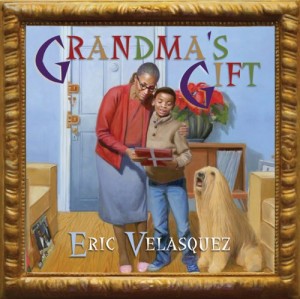
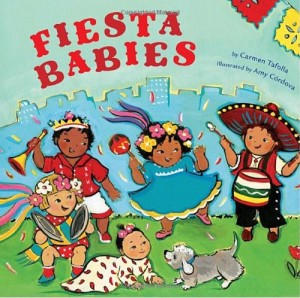
Thank you, Kerry! Great pitch and great list. I'm definitely going to see if I can find those books!
Hi, Beth. Thanks for stopping by! Some of the books might be harder to find than others, but I hope you do find them!